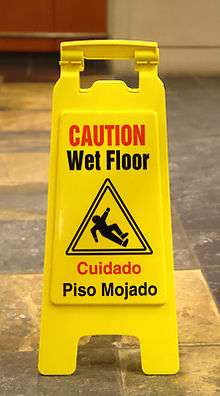Wet floor sign
A wet floor sign is used to warn people about wetfloors and to prevent them from slipping and falling.[1][2] Businesses often place such warnings to avoid negligence charges brought by people on their property. In many countries, if an injury results from a wet floor, the owner of the premises may be found liable for compensatory damages. Many lawyers specialize in such tort lawsuits. Sometimes wet floor signs are not enough.[3] Effectiveness in modifying behavior has been shown to be enhanced when a wet floor warning is also presented aurally every 10 seconds by a tape player.[4] Robotic cleaning equipment can use wet floor signs to know when its job is finished via sonar.[5]
Liability under United States common law
By the calculus of negligence, placing these signs in public or open areas available to the public makes sense even if there is a very small chance of anyone slipping. One factor in determining liability is the knowledge of the space or commercial business owner of the spill and the risk of falls. Because individuals such as commercial patrons and guests are generally expected to be less aware than a business owner, host, or the person responsible for the space, wet-floor signs are not usually found on personal property such as family dwellings. Nevertheless, a house guest can seek injury compensation, alleging liability for the tort of negligence. The highest standard of liability exists in the workplace, where workers' compensation may apply to any injury regardless of fault. The lowest standard exists for uninvited trespassers; some jurisdictions do recognize a duty to warn anticipated or unanticipated trespassers.[note 1] A "wet floor" sign placed at the entrance to a store, combined with periodic mopping of the entrance area during rainy periods to prevent an unreasonable accumulation of rain water, constitutes reasonable and ordinary care on the proprietor's part.[6] There are however many circumstances which make it difficult to have a clear and direct regulation or ordinances for best practices and law requirements. There have been many lawsuits involving slips and falls, one example is that of a Texas restaurant chain Starving Marvin (no longer in business) who was sued by a patron after walking over water and slipping injuring herself. There are new products available that are marketed to help prevent slips and falls for wet floors; there hasn't been a lawsuit as of June 2017 that involve wet floors with such treatments.[7]
See also
Notes
References
| Wikimedia Commons has media related to Wet floor signs. |
- ↑ Steven Di Pilla. Slip and Fall Prevention: A Practical Handbook. CRC Press. ISBN 1-56670-659-9.
- ↑ "Patent US7013590 - Floor sign - Google Patents". Google.com. Retrieved 2013-07-06.
- ↑ RJ Kendzior (2002), When 'wet floor' signs aren't enough, Occupational Health & Safety
- ↑ MS Wogalter, SL Young (1991), Behavioural compliance to voice and print warnings (PDF), Ergonomics
- ↑ Larson, Jan (1998). "RoboKent - a case study in man-machine interfaces". Industrial Robot: An International Journal. 25 (2): 95–100. ISSN 0143-991X. doi:10.1108/01439919810204577. Retrieved 2013-03-03.
- ↑ Adams v. Winn-Dixie Stores, Inc., 386 686 (Ga: Court of Appeals 1989).
- ↑ Robertson v. Starving Marvin Restaurant, Inc. (Ga: Jefferson County District Court 2016). Text
